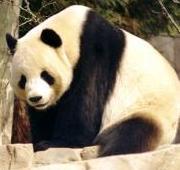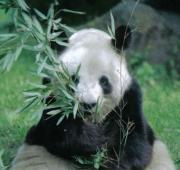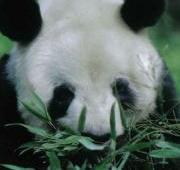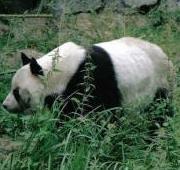 Giant Panda Bear Classification and Evolution
Giant Panda Bear Classification and EvolutionThe Giant Panda is a species of bear that is found in the mountains of central and western China. One of the most famous and easily identifiable animals in the world, the Giant Panda is also one of the rarest and is under immense threat in it's natural environment, primarily from habitat loss. The Giant Panda is unique among bears as they do not hibernate, have very small babies at birth and survive on a diet that is almost entirely vegetarian. Since the Giant Panda was first discovered by a French naturalist in 1869, it has become a global symbol for conservation with the World Wildlife Fund using it as their logo. The Chinese people also see the Giant Panda as a symbol of peace and numerous efforts have been made to try and protect the remaining populations in their native habitats.
 Giant Panda Bear Anatomy and Appearance
Giant Panda Bear Anatomy and Appearance
The Giant Panda is a medium to large sized bear that like other species has a large head, short tail and a long muzzle with a large nose, which gives them an excellent sense of smell. The thick fur of the Giant Panda is creamy-white in color with large patches of black on the limbs, shoulders, ears and nose, and distinctive black patches around their small eyes. The Giant Panda eats almost only bamboo and so has a number of physical adaptations to help with its consumption including an extension of their wrist bone which acts a bit like a thumb, allowing the Giant Panda to grip onto bamboo stems. They also have large jaws with strong jaw muscles that along with their flat molars, allow the Giant Panda to crush bamboo stems and leaves in order to extract the nutrients.

Historically, the Giant Panda would have been found throughout the lowlands of the Yangtze River Basin but increased Human activity in these areas has pushed the Giant Pandas high up into the mountains. Remote populations are still found in six different mountain ranges in central and western China, where they inhabit broadleaf and coniferous forests with a thick bamboo under-storey at elevations between 5,000 and 13,000 feet. These high-altitude forests are cool, cloudy and moist and are generally subjected to a high level of rainfall. It is thought that the unique colouration of the Giant Panda may help them to blend into these misty forests when they are foraging for food. It is however, the loss of these habitats to deforestation that is the biggest threat to the Giant Panda today as they rely almost solely on bamboo to survive.

The Giant Panda is a solitary animal that occupies a territory marked with secretions from scent glands and scratch marks on trees. Male Giant Pandas roam home ranges more than double the size of a female's, with his territory overlapping those of several female Giant Pandas with which he holds breeding rights. As bamboo is not particularly nutritious, the Giant Panda must eat lots of bamboo every day and can consume up to 30kg of bamboo leaves, shoots and stems which is roughly 40% of it's body weight. Giant Pandas therefore dedicate between 12 and 15 hours a day to munching bamboo which they do by sitting down, allowing their front paws to grip onto the plants. Even though the Giant Panda appears to spend it's whole day either eating or sleeping, they are also known to be good at climbing trees and can even swim well when needed.
Giant Panda Bear Reproduction and Life Cycles
Giant Pandas breed between March and May when the female begins to indicate her want to mate by making a series of groans and bleats to attract a male. After a gestation period that lasts for around five months, the female Giant Panda gives birth to one or two cubs in the base of a hollow tree or cave. Panda Bear cubs are very underdeveloped at birth measuring as little as 15cm and weighing only 100g, they are made even more vulnerable by the fact that they are also blind and hairless and don't begin to crawl until they are nearly three months old. Even if a female gives birth to twins she can only care for one that rides on her back until it is 6 months old and is then able to precariously trot beside her. Panda Bear cubs are weaned when they are around a year old but don't leave their mother until they are 18 months old. Some cubs may stay with their mother for a few years until she becomes pregnant again and they leave to establish a territory of their own.
Giant Panda Bear Diet and Prey
Despite being classified as a carnivorous animal (not to mention a species of bear), the Giant Panda eats almost exclusively bamboo in the forest surrounding it. Known to consume more than 30 different species of bamboo plant, Giant Pandas feed on different parts of the plant at different times of year in order to get the most out of it. Capable of eating up to 30kg of bamboo a day, the Giant Panda uses it's strong jaws to crush the various plant parts into a more easily digestible paste. Spending more than half of their day eating, Giant Pandas also supplement their diet with other plants including grasses and fruits, as well as rodents and birds on occasion. Even though they can eat nearly half of their body weight in bamboo parts in just one day, the Giant Panda still needs to drink water and does so from mountain streams that are supplied by the melting ice and snow higher up the slopes.
Giant Panda Bear Predators and Threats
Due to the large size and unique habitat of the Giant Panda, adults have no natural predators within their cool, bamboo-filled world. Cubs however are completely helpless until they are at least a year old and are preyed upon by larger predators such as Leopards and Birds of Prey. Humans however are the biggest threat to Giant Pandas in the Chinese mountains as they have hunted these remarkable animals for their unique fur, almost to extinction in some areas. Although harsh punishments for poaching have now slowed hunting down, Giant Pandas are under extreme threat from habitat loss in the form of deforestation for timber and land clearance for agriculture. They have therefore been forced into small and isolated pockets of their once vast natural range, and have been subjected to severe declines in their population numbers.
Giant Panda Bear Interesting Facts and Features
The Giant Panda has always fascinated people and therefore goes by a number of different names with it's scientific name meaning "cat-foot black and white" and it's Chinese name translates literally to "Giant Bear Cat", as the Giant Panda has slits for pupils in their eyes much like a cat. They are also known as the Bamboo Bear by locals due to the enormous amount that they consume. Giant Panda cubs are so small at birth that they weigh about the same as an average mouse and at 100g are roughly 0.001% of their mother's weight. In the Qinling Mountains in China's Shaanxi Province, a small population of brown and white Giant Pandas can be found existing amongst the standard black and white ones. Giant Pandas communicate between one another using a series of calls, with 11 different Giant Panda noises having been identified.
Giant Panda Bear Relationship with Humans
The Giant Panda has been admired by people for hundreds of years but more for their beautiful black and white pelts in the past. Since their discovery by the western world and the realisation of their rareness in the wild, Giant Pandas have become one of the most well-known of the world's large animals with increasing projects and efforts being put in place to try and save them from extinction. They have however been drastically affected by increasing Human activity in their native habitats which has ultimately led to vast population declines and the isolation of the remaining populations. Despite their seemingly cuddly appearance though, the Giant Panda is a species of bear and although attacks on Humans are rare, it is not unheard of for harm to be caused to people (particularly those who attempt to enter captive enclosures).
Giant Panda Bear Conservation Status and Life Today
Today, the Giant Panda is listed by the IUCN as being an animal species that is Endangered in it's natural environment and faces extinction in wild in the near future if more is not done to protect it. Although the Chinese government has created 33 Giant Panda reserves and more than 50% of it's natural habitat is now protected by law, less than 1,500 individuals are thought to remain in the wild. Extensive research continues to go into preventing the Giant Panda from becoming extinct but it simply cannot survive without it's unique bamboo forests.

